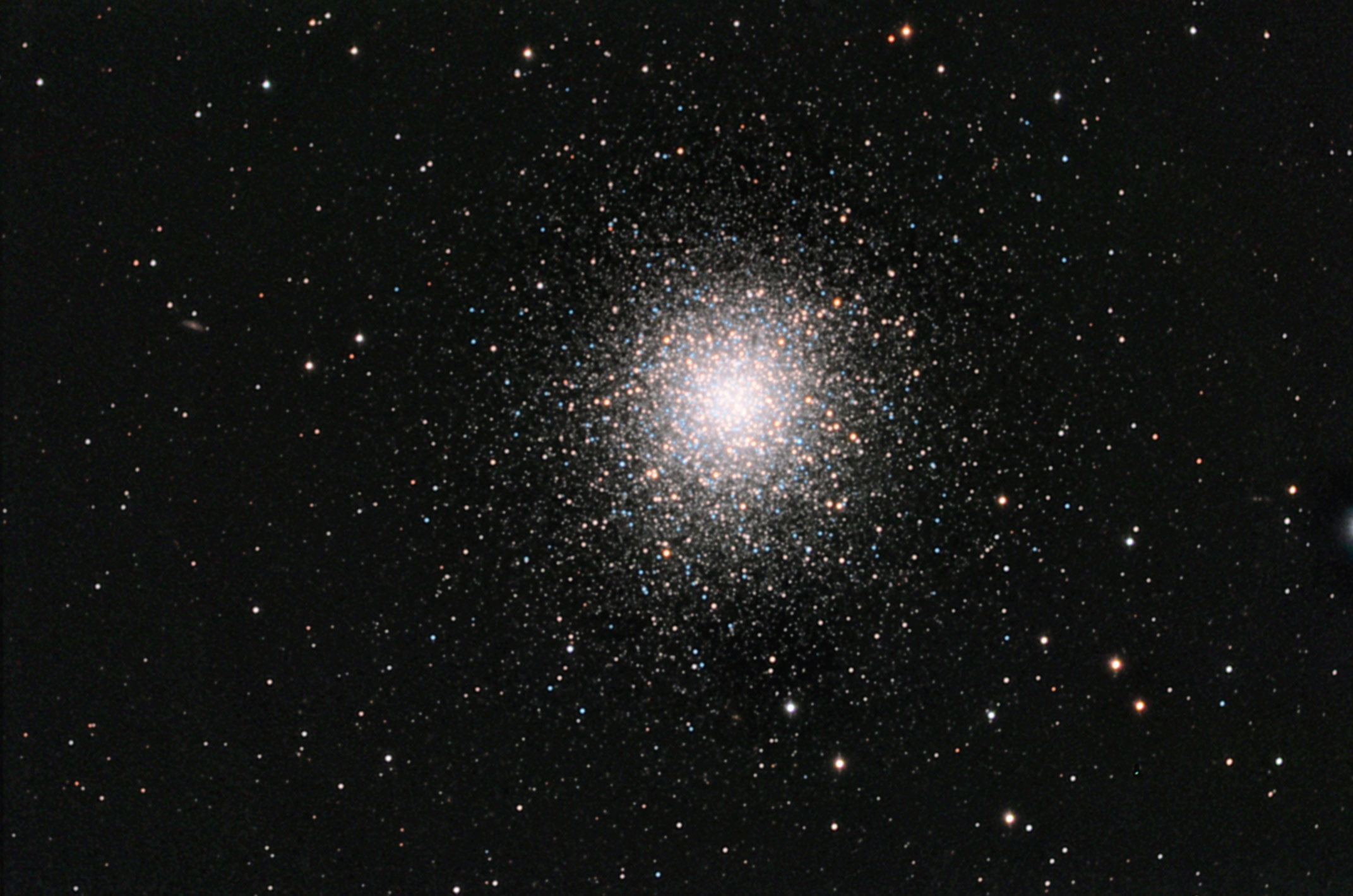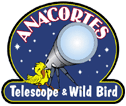News
75 Years Ago Today, Chuck Yeager Breaks the Sound Barrier

75 years ago today, on October 14, 1947, Charles E. “Chuck” Yeager became the first man to fly faster than the speed of sound when he piloted his X-1 rocket plane to a speed of Mach 1.06, or 700 mph. During World War II, Chuck Yeager distinguished himself in aerial combat over France and Germany during the years 1943-1945 by shooting down 13 enemy aircraft, including one of Germany's first jet fighters. In July 1966 he assumed command of the 405th Fighter Wing at Clark Air Base in the Philippines and flew 127 missions Vietnam. All in all, Chuck Yeager flew more than 10,000 hours in more than 361 different makes and models of military aircraft. In addition to the Collier Trophy, which he received in 1948 for breaking the sound barrier, he was awarded the MacKay Trophy in 1948 and the Harmon International Trophy in 1954.
Svante Pääbo Wins Nobel Prize for Deciphering the Neanderthal Genome

This year, the Nobel Prize for Physiology or Medicine went to Svante Pääbo, Director of the Max Planck Institute for Evolutionary Anthropology in Leipzig, Germany. Dr. Pääbo is no stranger to readers of Astromart News, as we have followed his work in early human genomics since 2009 when he and his team generated a first draft sequence for more than 60 percent of the Neanderthal genome. In 2014, his team succeeded in deciphering nearly 100 percent of the Neanderthal genome. This made a comparison with the genomes of today's humans possible. When Pääbo's team first published the Neanderthal mitochondrial genome, nothing seemed to indicate an exchange of genes between modern day humans and Neanderthals when they coexisted in close proximity. However, when Pääbo succeeded in deciphering the nuclear Neanderthal genome, it became clear that Neanderthals passed on large parts of their genome to modern humans. It turns out that one to three percent of the genomes of people living outside of Africa today stem from Neanderthals. An interesting side note -- Svante Pääbo's father, Sune Bergström, received the Nobel Prize for Physiology and Medicine in 1982.
Sputnik 1 – 65 Years Ago Today
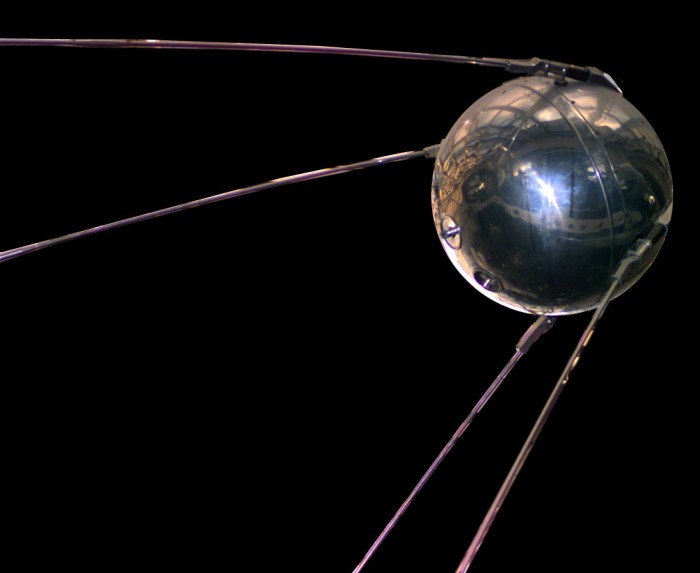
History changed 65 years ago today, on October 4, 1957, when the Soviet Union successfully launched Sputnik 1. The world's first artificial satellite was about the size of a beach ball -- about 23 inches in diameter -- and weighed less than 190 pounds. It took about 98 minutes to orbit the Earth on its elliptical path. That single launch ushered in a whole array of new political, military, technological, and scientific developments in the years that followed. While the Sputnik launch was a single event, it marked the start of the Space Age… and the US - USSR space race. While President Eisenhower congratulated the Soviets and tried to downplay the importance of the accomplishment, he misjudged the public reaction to the event. The launch of Sputnik 1 had a "Pearl Harbor-like" effect on the American public psyche. It was a shock that exposed a significant technological gap in US capabilities and in the years to come, provided the necessary impetus for increased spending in aerospace endeavors, technical and scientific educational programs, and the chartering of new federal agencies to manage air and space research and development.
55 Years Ago Today, Pete Knight Set the World Speed Record for a Winged Aircraft – The Record Still Stands

55 years ago today, on October 3, 1967, William John “Pete” Knight set a world aircraft speed record for a manned aircraft by piloting his X-15A-2 to Mach 6.7 or 4520 miles per hour (7274 km/h) -- a record that still stands today. During his 16 flights in the X-15, Knight also became one of only eight test pilots to earn Astronaut Wings by flying an airplane to space, reaching an altitude of 280,500 feet (85,500 m). After nearly ten years of test flying at Edwards Air Force Base in California, Knight went to Southeast Asia in 1968 where he completed a total of 253 combat missions in an F-100 Super Saber during the Vietnam War. After 32 years of service and more than 6000 hours in the cockpits of more than 100 different aircraft, he retired from the US Air Force as a Colonel in 1982. Pete Knight was a test pilot, aeronautical engineer, Vietnam War combat pilot, astronaut, and even for a short time, a politician. Knight passed away in 2004 at age 74, truly an American hero… As were the rest of the brave test pilots who participated in the X-15 program.
Kiss the Sky Tonight -- Month of October 2022
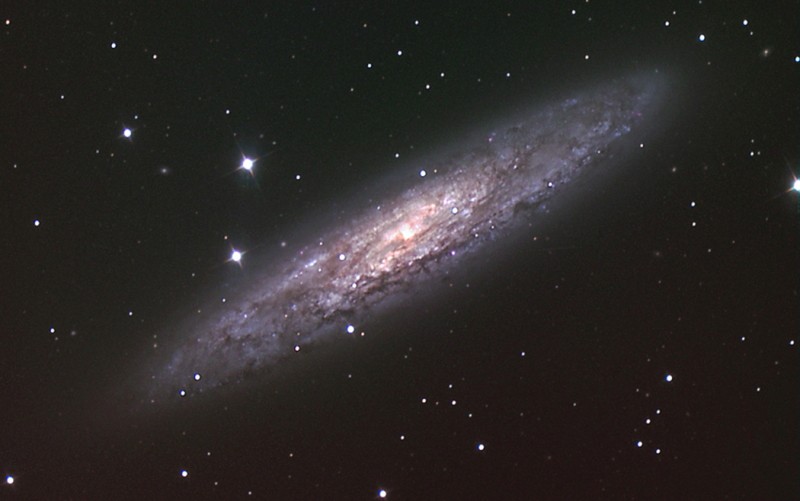
Welcome to the night sky report for October 2022 -- Your guide to the constellations, deep sky objects, planets, and celestial events that are observable during the month. Enjoy the two giant planets Jupiter and Saturn all night throughout the month. Then watch as Mars begins its retrograde motion, moving westward each night instead of eastward, for the next few months. Finally, check out the Orionid meteors overnight on Oct. 20th. The crisp, clear October nights are also full of celestial showpieces for the deep sky gazer too. Find Pegasus, the flying horse of Greek myth, to pinpoint dense globular star clusters and galaxies. Look for M15, NGC 7331, and M31 - the Andromeda Galaxy. The night sky is truly a celestial showcase. Get outside and explore its wonders from your own backyard.
Frank Drake, of Drake Equation Fame, Passes Away at Age 92
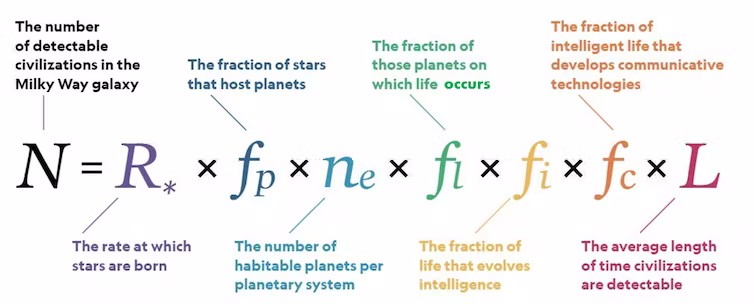
How many intelligent civilizations should there be in our galaxy right now? In 1961, the US astrophysicist Frank Drake, who passed away on September 2, 2022 at the age of 92, came up with an equation to estimate this. Whatever reasonable values you feed into the equation, it is hard to avoid the conclusion that we shouldn’t be alone in the galaxy. Drake remained a proponent and a supporter of the search for extraterrestrial life throughout his days. Today, there are about 100 scientists at the SETI Institute working on nearly 100 research questions and each of these topics can be related to one of the terms in the Drake Equation.
NSF Inaugurates the World’s Most Powerful Solar Telescope – The Daniel K. Inouye Solar Telescope in Hawaii
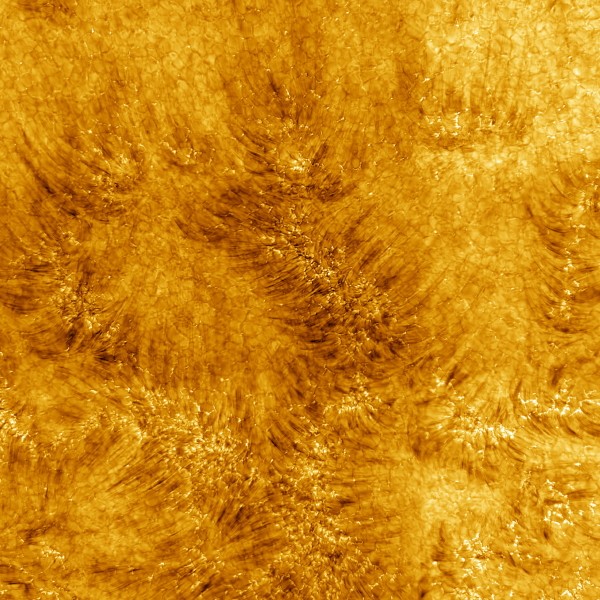
On August 31, 2022, a delegation of National Science Foundation leaders, congressional dignitaries, and members of both the scientific and Native Hawaiian communities gathered near the summit of Haleakalā, Maui, Hawaii, to commemorate the inauguration of the world’s most powerful solar telescope -- The NSF’s Daniel K. Inouye Solar Telescope. It promises to reveal the Sun in ways never seen before and the images and data that will be produced by the Inouye Solar Telescope will write the next chapters of solar physics research. The inauguration put a stamp on an ambitious, multi-decade project to provide the world with its greatest solar observatory and marked the beginning of the Inouye Solar Telescope’s 50-year journey to revolutionize our understanding of the Sun, its magnetic behavior, and its influence on Earth.
Kiss the Sky Tonight -- Month of September 2022

Welcome to the night sky report for September 2022 -- Your guide to the constellations, deep sky objects, planets, and celestial events that are observable during the month. In September, Pegasus becomes increasingly prominent in the southeastern sky, allowing stargazers to locate globular clusters M2 (NGC 7089), M30 (NGC 7099), as well as a nearby double star, Alpha Capricorni, which is an optical double (but not a binary pair). Also, Mars on the move during the month and it is prime viewing time for Jupiter. The night sky is truly a celestial showcase, so get outside and explore its wonders from your own backyard.
Lunar Mining and Territorial Claims Fall into a Gray Area of International Law
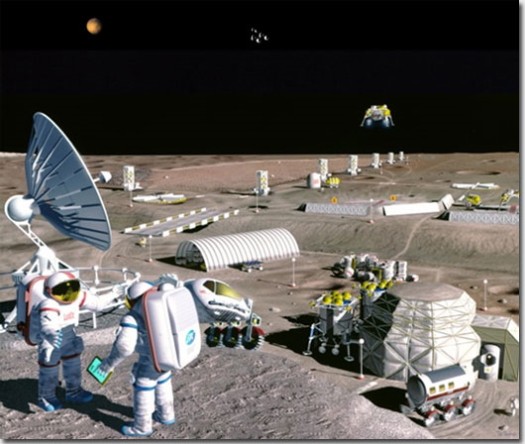
It’s been 50 years since humans last visited the Moon, and even robotic missions have been few and far between. But the Earth’s only natural satellite is about to get crowded. At least six countries and a flurry of private companies have publicly announced multiple missions to the Moon to occur within the next decade. Many of these missions include plans for permanent lunar bases and are motivated in large part by ambitions to assess and begin utilizing the Moon’s natural resources. In the short term, resources would be used to support lunar missions, but in the long term, the Moon and its resources will be a critical gateway for missions to the broader riches of the Solar System. But these lofty ambitions collide with a looming legal question. The Outer Space Treaty – the 60-year-old agreement that guides human activity in space – forbids nations from claiming territory in space. This limitation includes the Moon, planets, and asteroids. So how will space resources be managed?
NASA’s Venerable Voyager 2 was Launched 45 Years Ago Today
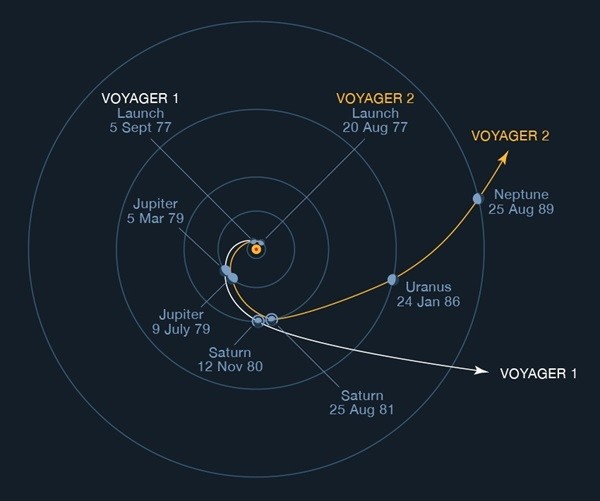
It was 45 years ago today, August 20, 1977, that NASA launched the Voyager 2 spacecraft on its historic mission to Jupiter and Saturn (and beyond). To double the chances of success, its twin spacecraft Voyager 1 was launched about a half month later on September 5, 1977. As originally designed, the Voyager twins were to conduct close-up studies of Jupiter and Saturn, Saturn's rings, and the larger moons of the two planets. But in the end, they accomplished much, much, more. In fact, the Voyagers are still exploring where nothing from Earth has flown before. To this day, the twin Voyager 1 and 2 spacecraft continue on their 45 year journey. In August 2012, Voyager 1 made the historic entry into interstellar space, the region between stars that is filled with material ejected by the death of nearby stars millions of years ago. Voyager 2 entered interstellar space on November 5, 2018. Both spacecraft are still sending scientific information about their surroundings through the Deep Space Network (DSN). After making a string of discoveries on Jupiter and Saturn, their missions were extended. Voyager 2 went on to explore Uranus and Neptune, and is still the only spacecraft to have visited those outer planets. The two Voyagers, still active after all these years, will continue to explore the outermost edges of the Sun's domain and beyond until their power sources run out and NASA loses contact.
NASA Says Largest Comet Ever Detected is Heading This Way… But It is Not a Threat to Earth

The size of Comet Bernardinelli-Bernstein, the largest icy comet nucleus ever seen by astronomers, has been determined by measurements made with the Hubble Space Telescope. The estimated diameter is approximately 85 miles across, making it larger than the state of Rhode Island. The nucleus is about 50 times larger than that found in most known comets. Its mass is estimated to be a staggering 500 trillion tons -- a hundred thousand times greater than the mass of a typical comet. Comet Bernardinelli-Bernstein follows a 3 million year long elliptical orbit, taking it as far from the Sun as roughly half a light-year. The comet is now less than 2 billion miles from the Sun and falling nearly perpendicular to the plane of our Solar System. It will never get closer than 1 billion miles away from the Sun, which is slightly farther than the distance of the planet Saturn… And that won't occur until the year 2031.
Free Roaming Black Hole Detected in Our Galaxy
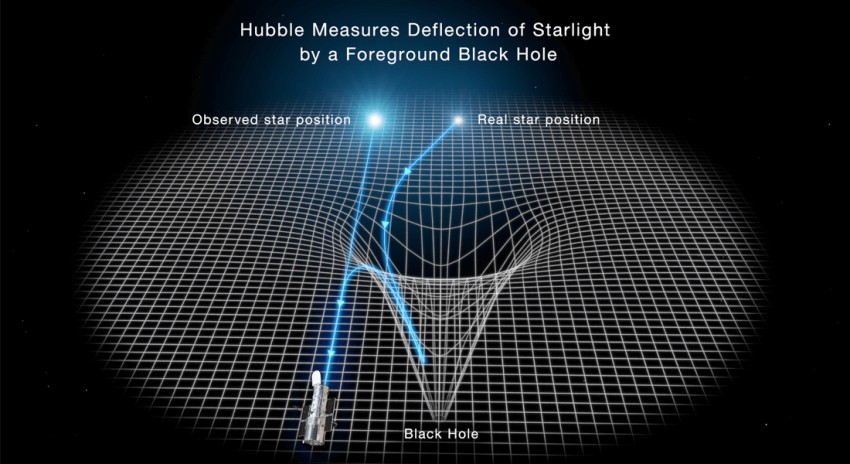
Astronomers estimate that there should be 100 million black holes roaming among the 100 billion stars in our galaxy. They are the remnants of supernova explosions that happened throughout the 10 billion years of the history of our galaxy. But since black holes emit no light of their own, they are extremely difficult to detect. Now, astronomers have at last come up with clear evidence for finding one in a needle-in-a-haystack search among a blizzard of stars seen toward the galactic center. Researchers from the Niels Bohr Institute (NBI), University of Copenhagen, contributed to the discovery, using the Danish 1.54 meter telescope at European Southern Observatory’s (ESO) La Silla observatory in Chile.
Kiss the Sky Tonight -- Month of August 2022

Welcome to the night sky report for August 2022 -- Your guide to the constellations, deep sky objects, planets, and celestial events that are observable during the month. The daily parade of four naked-eye planets in the mornings comes to an end this month. But there are still lots of great highlights, especially if you have access to binoculars. Plus, Saturn and Jupiter are returning to nighttime skies. In August, a flock of star-studded figures soars overhead. Look for the constellation Lyra, shaped as a small parallelogram, which points to Epsilon Lyrae and the Ring Nebula. You can also spot three bright summer stars: Vega, Deneb, and Altair, which form the Summer Triangle. And August is a great month to learn an easy-to-spot constellation – Cygnus the swan. The outlook for the Perseid meteors isn't great due to a full moon on the peak night of August 12, but still it's worth keeping an eye out for early Perseids after midnight the week before. The night sky is truly a celestial showcase. Get outside and explore its wonders from your own backyard.
The South Pole Telescope Looks Deep Into the Universe’s Beginnings

Surveying the cosmos from its isolated position in Antarctica, a collaborative project aims to reveal insights about the Universe’s beginnings. The South Pole Telescope (SPT), located at the Amundsen–Scott South Pole Station, is a sub-millimeter observatory that performs measurements of the Cosmic Microwave Background (CMB). The observatory is part of the Event Horizon Telescope (EHT), a globe-spanning multi-telescope project that recently captured the first image of a black hole at the center of a nearby galaxy. Since the 33-foot telescope began operating in 2007, it has helped researchers discover over 1000 giant galaxy clusters, including some truly exceptional ones, and has changed our understanding of the period when the first stars formed about 14 billion years ago, when the Universe was only 380,000 years old.
NASA Reveals James Webb Space Telescope's First Images

The dawn of a new era in astronomy has begun as the world gets its first look at the full capabilities of NASA’s James Webb Space Telescope, a partnership between NASA, ESA (European Space Agency), and CSA (Canadian Space Agency). The telescope’s first full-color images and spectroscopic data were released this week from NASA’s Goddard Space Flight Center in Greenbelt, Maryland. The selected astronomical targets represent the first wave of full-color scientific images and spectra the observatory has gathered and the official beginning of Webb’s general science operations. These first images from the world’s largest and most powerful space telescope demonstrate Webb at its full power, ready to begin its mission to explore the infrared universe.
Funding Member
Sponsors
- Rouz Astro
- astronomy-shoppe
- AstroMart LLC
- SellTelescopes.com
- APM-Telescopes
- Desert Sky Astro Products
- Anacortes Telescope
- Matsumoto Company
- FocusKnobs
- BBLABS LLC
- Bob's Knobs
- OMI OPTICS USA LLC
- RemoteSkies.net
- BW
- ASTROPHOTOGRAPHY BY MARTIN PUGH
- Astromart Customer Service
- Waite Research
View all sponsors
